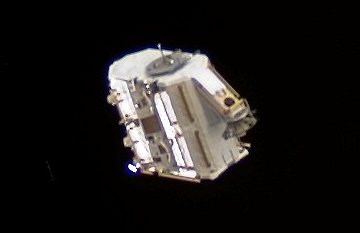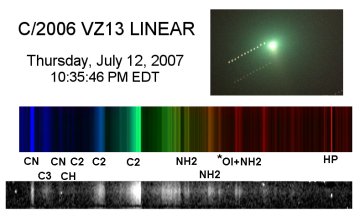 Where's Saturn? Is that a UFO--or the ISS? What's the name of that star? Get the answers from mySKY--a fun new astronomy helper from Meade. Where's Saturn? Is that a UFO--or the ISS? What's the name of that star? Get the answers from mySKY--a fun new astronomy helper from Meade. AURORA WATCH: A solar wind stream is heading toward Earth and it could spark a mild geomagnetic storm when it arrives late on July 26th. Unfortunately, auroras may be difficult to see because of interference from the nearly-full Moon. SPACE JUNK: Weight: 1400-lb. Size: Akin to a double-wide refrigerator. It is, in short, one big piece of space junk: 
Photo credit: The crew of the International Space Station. [more]
Pictured above is the Early Ammonia Servicer (EAS), hurled into space this week by astronauts working outside the International Space Station: movie. The EAS was installed in 2001 as an ammonia reservoir for the station's internal cooling system, but it was no longer needed after an improved cooling system was activated in 2006. So, astronauts pushed it overboard to make room for new construction. The tank is now circling Earth. On July 25th, Kevin Fetter used a low-light video camera to photograph EAS tumbling across the sky over his home in Brockville, Ontario: movie. "The flashes were about 6th magnitude," he estimates--not quite visible to the naked eye. The brightness will increase about a year from now when the orbit decays and EAS enters Earth's atmosphere as a flaming meteor. Stay tuned. COMET COLORS: What makes Comet Linear VZ13 blue-green? Answer: Cyanogen (CN), diatomic carbon (C2) and, surprisingly, a dash of amidogen (NH2). Those are the compounds identified by John Cordiale of Queensbury, NY, on July 12th when he passed light from the comet through an SBIG DSS7 spectrograph: 
Click on the image for photo details
Each molecule in the comet's atmosphere emits light of a signature color (or colors) when illuminated by the sun--a process called "resonant florescence." A spectrograph spreads the colors out for easy identification. Only one problem: The comet is very faint, requiring an exposure of nearly 30 minutes through a 10-inch telescope to produce the data shown above. Considerable skill was required. "This is the most detailed comet spectrum I have gotten so far," says Cordiale. "It was the first time I pulled out the NH2 lines. Even though this comet is not the brightest, it has proved to be very interesting."
.2007 Noctilucent Cloud Gallery
[Night-Sky Cameras] ["Noctilucent Cloud"--the song] | 
